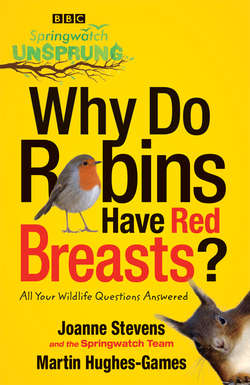Читать книгу Springwatch Unsprung: Why Do Robins Have Red Breasts? - Jo Stevens - Страница 7
At a Snail’s Pace
ОглавлениеHow long do snails live? Do they get slower with age? Nature Lover
Both the lifespan and speed of a snail vary according to the species. There are thousands of snail species worldwide but of those only about twenty are regularly found in our gardens. Whether or not they live to a ripe old age depends on how well they avoid parasites, disease or predators – and there are plenty of these around; thrushes in particular will readily make a meal of a juicy snail or two. Most snails will survive for only two or three years, but Edible or Roman snails (Helix pomatia) can live for several decades – the oldest known individual reached an impressive 35 years old.
As well as predators and parasites, snails also have to endure extreme weather conditions. They have adapted to survive several months of dry or cold weather by covering their shell opening with an epiphragm – a layer of mucus that dries out to form a barrier which prevents water loss. Some species, such as the Roman snail, can produce a much more substantial and solid epiphragm which is reinforced with calcium carbonate before the mollusc goes into hibernation. Snails can also protect themselves in winter by changing the composition of their blood, or haemolymph, to prevent it freezing. The common garden snail (Helix aspersa) can survive in temperatures down to minus 5 degrees Celsius.
Snails are renowned for their slowness, but they have no need to rush anywhere. The majority of species are herbivores, so they don’t have to chase after prey, and to escape most predators they need only to retreat within their shell. Snails may be slow but they are strong; when tested, one species was able to drag 50 times its own weight horizontally and nine times its weight vertically.
A snail moves by expanding and contracting its muscular foot in waves, and as it does so it secretes a slimy mucus that lubricates its path and reduces any friction on the surface beneath. You can watch how they do this by putting one on a clean drinking glass or windowpane. If you liquidise a little lettuce and smear some on the glass you may be able to see their tongue, or radula, in action too. While you’re there, you could test their speed. Garden snails can crawl up to 1.3 centimetres per second, equivalent to about 0.05 km/h. The fastest known garden snail was called Archie. ‘He’ (snails are hermaphrodites) slithered 33 centimetres in two minutes at the 1995 World Snail Racing Championships held in Norfolk. At the time of writing, Archie’s world record remains unbroken.
Archie’s racing days were numbered, though, because like most of us, he would have got slower with age. Scientists often use the common pond snail, Lymnaea stagnalis, as a model species for studying the central nervous system and investigating how brains change with age. Results so far show that older pond snails are more forgetful than young ones and feed more slowly. It seems that geriatric snails are generally more sluggish …
